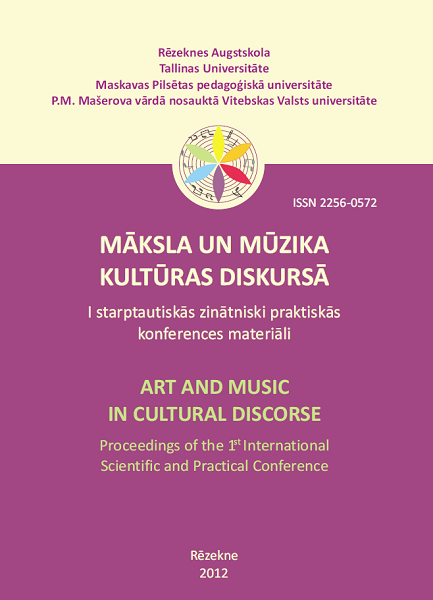The Development of Youth’s Artistic Communication Underthe Influence of the Development of Science and Information and Communication Technologies
DOI:
https://doi.org/10.17770/amcd2012.1223Keywords:
artistic communication, iconic signs, ICT, semioticsAbstract
Due to the development of the ICT a new type of student is created. These students are no more passive users of the system of eduaction, they are creating it themselves.Under the influence of the ICT, students use signs, icons and symbols in their everyday communication. The aim or the work - The influence and significance of the information and communication technologies on the development of youth’s artistic communication and creation of new signs. It has been observed that visual perception dominates for majority of people. This is also the reason why visual images and symbols have served as means of communication in the history of human development. Nowadays, numbers, letters and their combinations that contain special meaning and iconic signs are often used in students’ everyday communication. The ICT have brought some changes in students’ perception of the world. The experiment, made in the Art lesson by questioning the first graders, showed that existing ideas about the styles of art that children like at this age are in the contraversion with reality.Downloads
References
Agejevs, V. (2005). Semiotika.Rīga: Jumava.
Беспалов, Б. И. (1984). Действие: психологические механизмы визуального мышления. Мockвa.
Buiķis, A. (2001). Vai mēs esam tie, kas patiesībā esam. Rīga: Madris.
Bute, D. (2012). Sabiedrība, integrācija, izglītība. Starptautiskās zinātniskās konferences materiāli. Skolēnu mākslas komunikācijas veidošanās zinātnes un tehnikas attīstības ietekmē (31.-38.lpp.). Rēzekne. Latvijas centrālās statistika birojs, (2012). Skatīts 20.01.2012. http://www.csb.gov.lv.
Mācīšanās stili, (2012). Skatīts 10.02.2012. http://www.liis.lv/talakizglitiba/stili.htm.
Prensky, M. (2010). Digitaln Game-Based Learning, Mc Graw-Hill, New York, NY, Accessed October 2, 2010. Skatīts 06.10.2010. http://www.marcprensky.com/.
Prensky, M. (2011). The Reformers Are Leaving Our Schools in the 20th Century. Whymost U.S. school reformers are on the wrong track, and how to get our kids’ education right for the future. Skatīts 013.08.2012. http://www.marcprensky.com/writing/+PrenskyThe_Reformers_Are_Leaving_Our_Schools_in_the_20t h_Century-please_distribute_freely.pdf.
Priedīte, A. (2012). Kādu valodu lietojam interneta ziņu portālos – ārvalstu prakse. Skatīts 08.04.2012. http://www.lu.lv/filol/valoda/ind_3_publ_r_Priedites.htm.
Reņģe, J. (2002). Mācīšanās spēju attīšana. Rīga: Pētergailis


